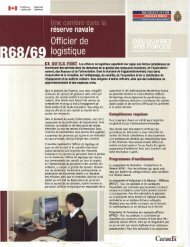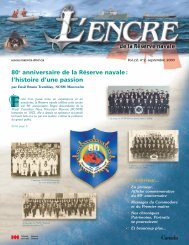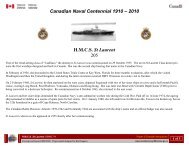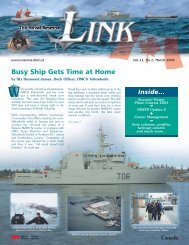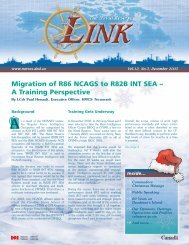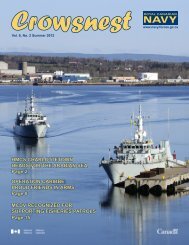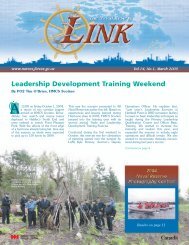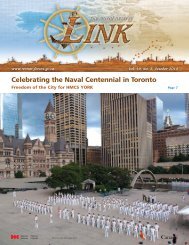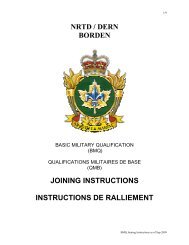Operation LANCASTER - Canadian Navy
Operation LANCASTER - Canadian Navy
Operation LANCASTER - Canadian Navy
Create successful ePaper yourself
Turn your PDF publications into a flip-book with our unique Google optimized e-Paper software.
H I S T O RY<br />
The Royal <strong>Canadian</strong> Naval Air Service –<br />
“The Fleet Air Arm”<br />
By Mr. Bruce Forsyth<br />
T<br />
he origins of the Royal <strong>Canadian</strong><br />
Naval (RCN) Air Service go back<br />
to World War I, when the Royal<br />
Naval Air Service (RNAS) was formed in<br />
April 1915. The RNAS was short lived<br />
however, disbanding in April 1918.<br />
Undeterred, Canada also formed a naval air<br />
service on 5 September 1918, but this<br />
v e n t u re ended with the signing of the<br />
Armistice in November 1918.<br />
During World War II, the British Admiralty<br />
revived the idea of a <strong>Canadian</strong> naval air service<br />
but Canada would have to wait until the<br />
end of WWII before this would come into<br />
being. For the duration, Royal <strong>Canadian</strong><br />
<strong>Navy</strong> pilots served with the Royal <strong>Navy</strong> Fleet<br />
Air Arm, distinguishing themselves as effective<br />
combat pilots. One of these pilots was<br />
Victoria Cross (VC) winner Lieutenant (N)<br />
Robert Hampton Gray, a member of the<br />
Royal <strong>Canadian</strong> <strong>Navy</strong> Volunteer Reserve<br />
aboard HMS FORMIDABLE. Lieutenant (N)<br />
Gray was posthumously awarded the VC for<br />
actions on 9 August, 1945, when he led<br />
an attack on Japanese shipping in Onagawa<br />
Wan, Japan.<br />
Canada did have two aircraft carriers<br />
during WWII: HMCS NABOB and HMCS<br />
PUNCHER. Although <strong>Canadian</strong> sailors<br />
manned both ships, they were commissioned<br />
as Royal <strong>Navy</strong> ships and the aircrews<br />
were members of the Royal <strong>Navy</strong> Fleet<br />
Air Arm.<br />
On 24 January 1946, the RCN commissioned<br />
its first official aircraft carrier,<br />
HMCS WARRIOR. Two air squadrons were<br />
also formed the same day: 825 Squadron<br />
and 803 Squadron, making them the<br />
first official RCN air squadrons. HMCS<br />
WARRIOR served the RCN for a brief<br />
two-year period, before it was replaced<br />
by HMCS MAGNIFICENT.<br />
20 LI N K Vol.15, No.3, December 2006<br />
The new air element was christened the<br />
Fleet Air Arm in May 1946, following in<br />
the footsteps of the Royal <strong>Navy</strong>. A year<br />
later, the name was officially changed to<br />
the Naval Air Branch, but the name “Fleet<br />
Air Arm” remained in the lexicon of many<br />
naval personnel in an unofficial capacity.<br />
Naval aviation in Canada received a boost<br />
with the acquisition of Royal <strong>Canadian</strong><br />
Air Force (RCAF) Station Dartmouth in<br />
September 1948, which was re - n a m e d<br />
Royal <strong>Canadian</strong> Naval Air Station HMCS<br />
SHEARWATER. RCN air squadrons had<br />
been based in Dartmouth since 1946, but<br />
now they had a place to truly call their own.<br />
In April 1950, the RCN took possession of<br />
75 Avenger aircraft from the United States<br />
<strong>Navy</strong>, fitted with the latest anti-submarine<br />
warfare (ASW) equipment. The first ASW<br />
helicopter squadron was formed aboard<br />
HMCS MAGNIFICENT in 1955. The success<br />
of helicopters aboard ship was particularly<br />
significant in that when the St. Laurent class<br />
destroyers came on line in the early 1960s,<br />
they were all equipped with helicopter<br />
flight-decks, a uniquely <strong>Canadian</strong> creation.<br />
The RCN Reserve was also given authority<br />
to form air squadrons. In May 1953, VC<br />
920 Squadron was formed as tender to<br />
HMCS YORK. Next came VC 921, formed<br />
as a tender to HMCS CATARAQUI on<br />
30 September, 1953, and VC 922, formed<br />
as tender to HMCS MALAHAT on 1 December,<br />
1953. HMCS MONTCALM and<br />
HMCS TECUMSEH formed VC 923<br />
and VC 924 Squadrons respectively on<br />
1 June, 1954.<br />
Although HMCS STAR did not have its own<br />
s q u a d ron due to its close proximity to<br />
HMCS YORK, the unit maintained a support<br />
unit for ground crew and maintenance.<br />
HMCS STAR also had one Swordfish and<br />
two Seafire aircraft for their use at RCAF<br />
Station Hamilton and the unit conducted<br />
joint training with HMCS YORK at RCAF<br />
Station Downsview.<br />
HMCS YORK’s VC 920 squadron had the<br />
distinction of being the only Naval Reserve<br />
air squadron to achieve carrier qualification.<br />
Markings were painted on the runways at<br />
RCAF Station Downsview so that YORK’s<br />
pilots could practice simulated aircraft carrier<br />
take-offs and landings.<br />
In November 1955, the Royal <strong>Canadian</strong><br />
<strong>Navy</strong> took possession of its first fighter jet,<br />
the F2H3 Banshee all-weather jet fighter,<br />
the crown jewel of naval aviation in Canada.<br />
VF 870 and VF 871 Squadrons replaced<br />
their Sea Fury aircraft with the new<br />
Banshee, flying them from the newly commissioned<br />
HMCS BONAVENTURE as well<br />
as HMCS SHEARWATER. The Banshee jet<br />
fighters would play an important role in the<br />
defence of Canada and, as a great source of<br />
pride for Canada’s naval aviators, the<br />
Banshee even out-performed the RCAF’s<br />
CF-100 jet fighter.<br />
In 1960, the RCN assumed control of the<br />
airfield at the former RCAF Station Debert<br />
as a training facility but this would be shortlived<br />
as the Debert facility was abandoned in<br />
the late 1960s.<br />
Despite all the successes of the Royal<br />
<strong>Canadian</strong> Naval Air Branch, the climate was<br />
once again turning against Canada's naval<br />
aviators. In 1962, the RCN turned down<br />
the opportunity to buy a United States <strong>Navy</strong><br />
Essex-class carrier, with its state-of-the-art<br />
flight deck. The Banshees were slated for<br />
replacement, but instead of acquiring a new<br />
jet fighter, the government disbanded the<br />
Banshee squadrons.<br />
The RCN Reserve also suffered due to the<br />
downturn in <strong>Canadian</strong> naval aviation. By<br />
1964, all RCN Reserve air squadrons had<br />
been paid off.



